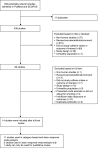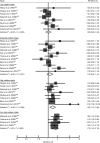Maternal caffeine intake during pregnancy and risk of pregnancy loss: a categorical and dose-response meta-analysis of prospective studies
- PMID: 26329421
- PMCID: PMC10271029
- DOI: 10.1017/S1368980015002463
Maternal caffeine intake during pregnancy and risk of pregnancy loss: a categorical and dose-response meta-analysis of prospective studies
Abstract
Objective: To assess the association between maternal caffeine intake and risk of pregnancy loss using a systematic review and meta-analysis.
Design: Categorical and dose-response meta-analysis of prospective studies.
Setting: Relevant articles were identified by searching MEDLINE and SCOPUS databases through 30 January 2015. Two authors independently extracted information from eligible studies. Random-effects models were used to derive the summary relative risks (RR) and corresponding 95% CI for specific categories of caffeine consumption and for a continuous association using generalized least-squares trend estimation.
Subjects: A total of 130 456 participants and 3429 cases in fourteen included studies.
Results: Compared with the reference category with no or very low caffeine intake, the RR (95% CI) of pregnancy loss was 1·02 (0·85, 1·24; I(2)=28·3%) for low intake (50-149 mg/d), 1·16 (0·94, 1·41; I 2=49·6%) for moderate intake (150-349 mg/d), 1·40 (1·16, 1·68; I(2)=18·6%) for high intake (350-699 mg/d) and 1·72 (1·40, 2·13; I(2)=0·0%) for very high intake (≥ 700 mg/d). In the dose-response analysis, each 100 mg/d increment in maternal caffeine intake (~1 cup of coffee) was associated with 7% (95% CI 3%, 12%) higher risk of pregnancy loss. Our results may have been affected by publication bias, but the association remained significant for the subset of larger studies. Furthermore, adjustment for smoking and pregnancy symptoms may have been incomplete, potentially resulting in residual confounding.
Conclusions: Albeit inconclusive, higher maternal caffeine intake was associated with a higher risk of pregnancy loss and adherence to guidelines to avoid high caffeine intake during pregnancy appears prudent.
Keywords: Caffeine; Coffee; Miscarriage; Pregnancy; Pregnancy loss; Spontaneous abortion; Stillbirth.
Figures




Similar articles
-
Drugs for preventing postoperative nausea and vomiting in adults after general anaesthesia: a network meta-analysis.Cochrane Database Syst Rev. 2020 Oct 19;10(10):CD012859. doi: 10.1002/14651858.CD012859.pub2. Cochrane Database Syst Rev. 2020. PMID: 33075160 Free PMC article.
-
Antioxidants for female subfertility.Cochrane Database Syst Rev. 2017 Jul 28;7(7):CD007807. doi: 10.1002/14651858.CD007807.pub3. Cochrane Database Syst Rev. 2017. Update in: Cochrane Database Syst Rev. 2020 Aug 27;8:CD007807. doi: 10.1002/14651858.CD007807.pub4. PMID: 28752910 Free PMC article. Updated.
-
Insulin-sensitising drugs (metformin, rosiglitazone, pioglitazone, D-chiro-inositol) for women with polycystic ovary syndrome, oligo amenorrhoea and subfertility.Cochrane Database Syst Rev. 2017 Nov 29;11(11):CD003053. doi: 10.1002/14651858.CD003053.pub6. Cochrane Database Syst Rev. 2017. PMID: 29183107 Free PMC article.
-
Application of seminal plasma to female genital tract prior to embryo transfer in assisted reproductive technology cycles (IVF, ICSI and frozen embryo transfer).Cochrane Database Syst Rev. 2018 Feb 28;2(2):CD011809. doi: 10.1002/14651858.CD011809.pub2. Cochrane Database Syst Rev. 2018. PMID: 29489026 Free PMC article.
-
Pain management for medical abortion before 14 weeks' gestation.Cochrane Database Syst Rev. 2022 May 13;5(5):CD013525. doi: 10.1002/14651858.CD013525.pub2. Cochrane Database Syst Rev. 2022. PMID: 35553047 Free PMC article.
Cited by
-
The Impact of Maternal Eating Disorders on Dietary Intake and Eating Patterns during Pregnancy: A Systematic Review.Nutrients. 2019 Apr 13;11(4):840. doi: 10.3390/nu11040840. Nutrients. 2019. PMID: 31013875 Free PMC article.
-
Australasian recurrent pregnancy loss clinical management guideline 2024, part II.Aust N Z J Obstet Gynaecol. 2024 Oct;64(5):445-458. doi: 10.1111/ajo.13820. Epub 2024 Jun 27. Aust N Z J Obstet Gynaecol. 2024. PMID: 38934293 Free PMC article.
-
Caffeine consumption during early pregnancy impairs oviductal embryo transport, embryonic development and uterine receptivity in mice.Biol Reprod. 2018 Dec 1;99(6):1266-1275. doi: 10.1093/biolre/ioy155. Biol Reprod. 2018. PMID: 29982366 Free PMC article.
-
Prevalence and consumption pattern of kolanut among pregnant women in Ibadan metropolis.Sci Rep. 2023 Sep 2;13(1):14422. doi: 10.1038/s41598-023-41754-6. Sci Rep. 2023. PMID: 37660226 Free PMC article.
-
Novel approaches to the management of recurrent pregnancy loss: The OPTIMUM (OPtimization of Thyroid function, Thrombophilia, Immunity, and Uterine Milieu) treatment strategy.Reprod Med Biol. 2021 Sep 14;20(4):524-536. doi: 10.1002/rmb2.12412. eCollection 2021 Oct. Reprod Med Biol. 2021. PMID: 34646081 Free PMC article.
References
-
- Sims MA & Collins KA (2001) Fetal death: a 10-year retrospective study. Am J Forensic Med Pathol 22, 261–265. - PubMed
-
- García-Enguídanos A, Calle ME, Valero J et al.. (2002) Risk factors in miscarriage: a review. Eur J Obstet Gynecol Reprod Biol 102, 111–119. - PubMed
-
- Lawn JE, Blencowe H, Pattinson R et al.. (2011) Stillbirths: where? When? Why? How to make the data count? Lancet 377, 1448–1463. - PubMed
-
- Eteng MU, Eyong EU, Akpanyung EO et al.. (1997) Recent advances in caffeine and theobromine toxicities: a review. Plant Foods Hum Nutr 51, 231–243. - PubMed
Publication types
MeSH terms
Substances
LinkOut - more resources
Full Text Sources
Medical

